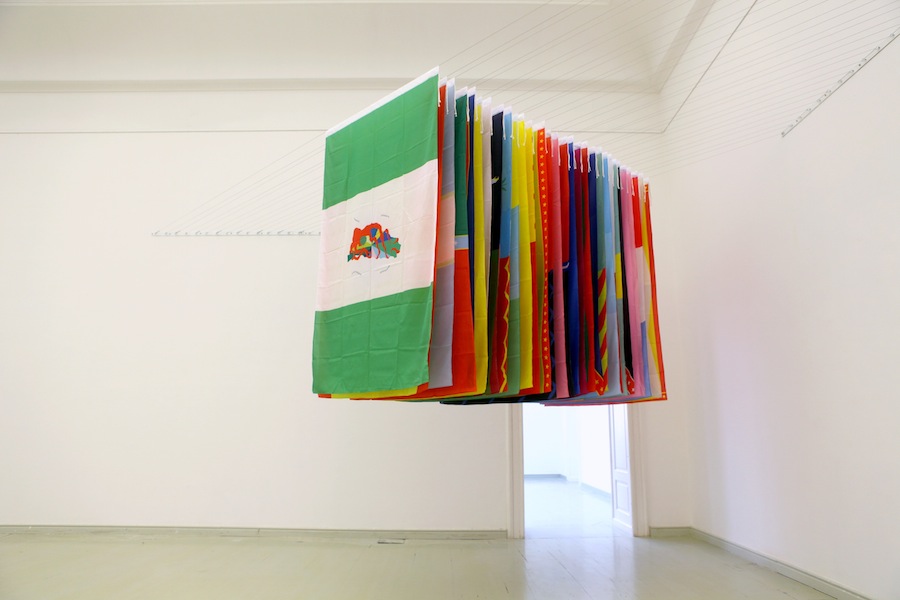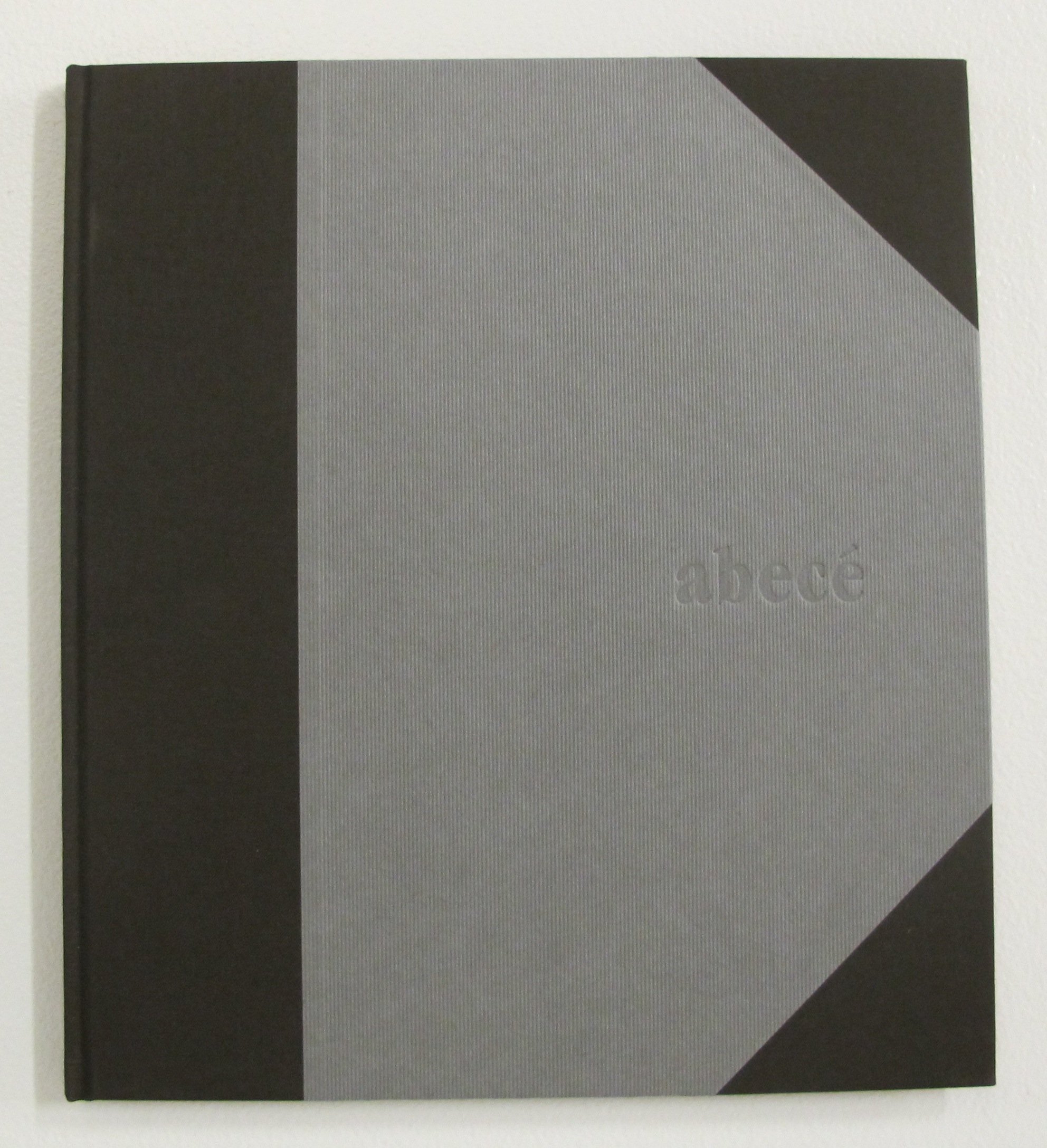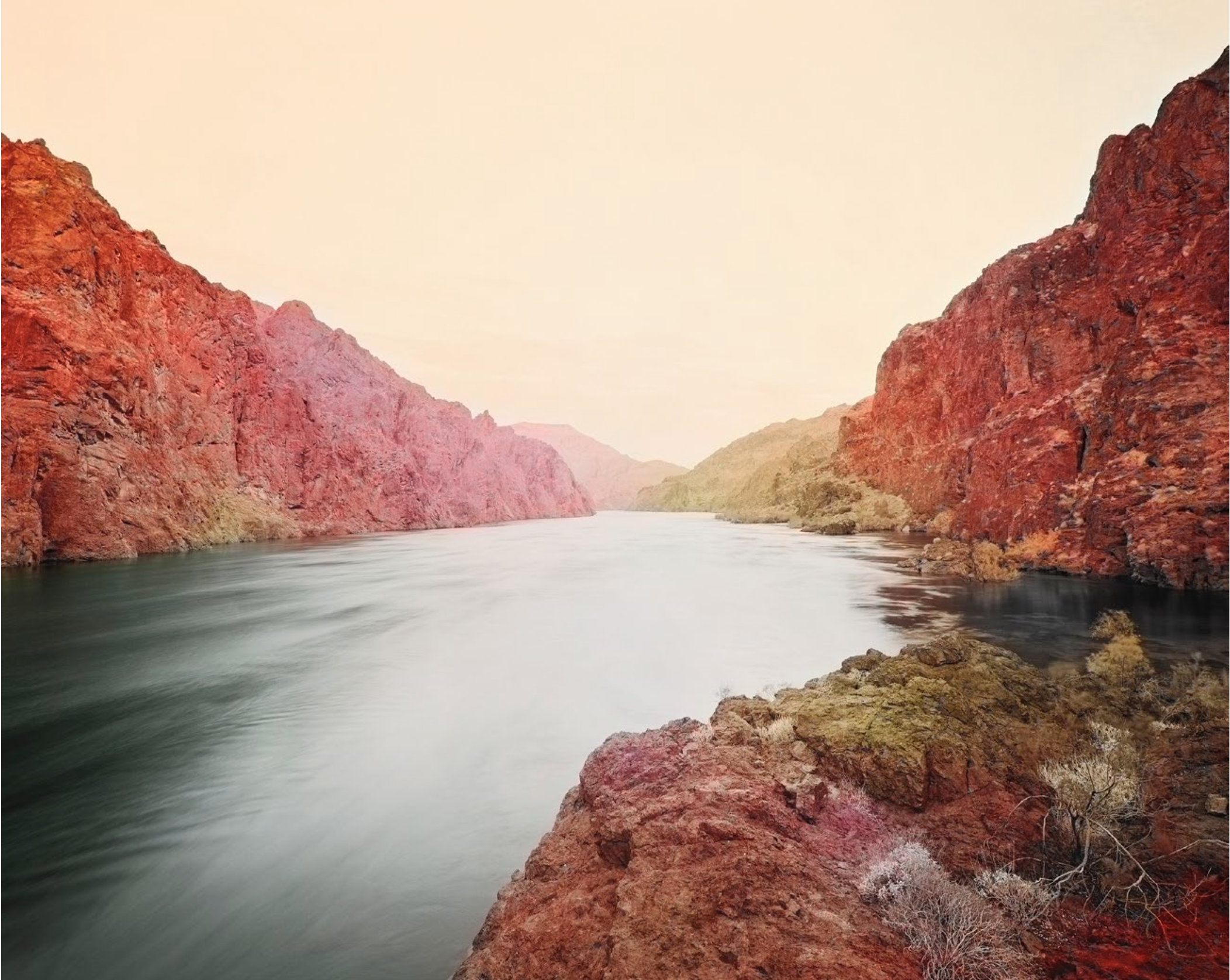
© » KADIST
Egle Jauncems
The title of this work by Egle Jauncems, The Paler King I , is taken from an unfinished novel by the late David Foster Wallace called The Pale King, published posthumously in 2015. Jauncems notes that the book is fragmented, following unrelated characters struggling with ennui and depression, navigating the pressures of modern reality. In her art practice, Jauncems has been interested in the lives of powerful and influential men for many years.

© » KADIST
Goddy Leye
Strongly influenced by history and memory, Goddy Leye’s paintings are based primarily on stories and mythologies. Containing ideas, emotions, and sensibilities, signs and symbols occupy an important place in Leye’s work, though he has to retrieve them from an interrupted history. The painting Animal was made in reference to an important precolonial kingdom, Bamun.

© » KADIST
Matt Mullican
Drawing & Print (Drawing & Print)
Mullican’s Stick Figure Drawings depict characters reduced to their most basic graphic representation. Glen is a simple silhouette, genderless and inspired by a found photo of a crime scene, in whom we recognize the generic sign of the universal symbol of a self-portrait. Mullican continually projects himself, sometimes physically, into the silhouette that he has created, allowing the artist to pass from one reality to another.

© » KADIST
Zach Reini
Particularly shaped by his own youth in the 1990s, his recent works have incorporated things like a marijuana leaf, a dragon-emblazoned chain wallet, metal grommets, and the ubiquitous (in the 90s) Stussy symbol. Reflecting and recouping elements from American youth culture, Reini’s works question how we package, mark, and express ourselves through manufactured symbols of identity. Reini has also used images of Mickey Mouse—Disney’s anthropomorphic icon—in numerous works, including in this pair of works, The More You Want…, …The Less You Get .

© » KADIST
Annette Kelm
Drawing & Print (Drawing & Print)
Percent for Art is seemingly concerned with “art enrichment” by state or city arts agencies role in it, managing the artist rosters, maintaining public art collections, commissioning artworks, selecting installation sites, among other things for aesthetic and cultural enhancement in both public and private real estate developments. For some, it’s also an opportunity to have desperately needed revenue to counter the displacement of artists and preserve a city or state’s creative spirit. The work, with its serial repetition of percentage signs across six separate bright red panels, appears as splashy retail signage for no apparent sale.

© » KADIST
Daniel Boccato
Parrot Drawings or Paintings look like children’s drawings and seem quite innocent. The parrot in both the Garden of Eden and the harems are associated with the symbol of purity and innocence. These symbols are found in Renaissance painting, especially in the Annunciations or the Virgins and child and later in Flemish portraits.

© » KADIST
Jean-Luc Moulène
Head Box by J ean-Luc Moulène i s not the representation of a space but a real space that remains in the domain of sculpture which the artist develops in parallel with his photographic practice. Created for an exhibition in Kitakyushu in Japan, it is painted green, a color that symbolizes life and creation in Japanese culture. Even though we are confronted with a hollow presence, this is above all a space to lodge a body in the vertical posture of the living.

© » KADIST
Miguel Angel Ríos
Superb production values and special effects that in the hands of Miguel Angel Rios do not get in the way or distracts from the content and deep essay of this work. The shadow of Modernity represented via a clear cube floats over and through a barren landscape in Latin America. Juxtaposing the corrupt politics of the land, with the artist’s struggles and questioning of the effects and burden of influence of Modernity.

© » KADIST
Miguel Angel Ríos
For Piedras Blancas , arguably his most ambitious and visually arresting video to date, Miguel Angel Ríos made 3,000 “piedras” out of a concrete/stone composite. The video is shot in arid, mountainous locations in Mexico (his adopted country) and Argentina (his home country). Over several months, Ríos scouted locations for natural-worn tributaries where he eventually allowed these balls to then thunder down the mountain.

© » KADIST
Jao Chia-En
30 Proposals of Flag explores the relationships between signs, meanings, aesthetics, and nations. The artwork consists of 30 flags layered together and hanging from the ceiling. Each flag is illustrated with Jao’s rendition of a possible coat of arms derived from Taiwan’s economic and political history.

© » KADIST
Hama Goro
Drawing & Print (Drawing & Print)
Hama Goro works with a traditional method called the Bogolan technique, which is inspired by a method used in Mali to color clothes. The ingredients of the various colors originate from natural products such as clay, leaves and bark. The colors had a symbolic significance and were used during ritual ceremonies.

© » KADIST
Zhu Jia
In this four-channel 10 min video installation different episodes play simultaneously on the four screens. The artist has arranged several different scenarios and symbolic props which make it easy for viewers to feel the pervasive ambiguity which cannot be put into words. On the one hand, our imagination is tempted by the delicate details, but on the other hand, our imagination is limited through a very rigorous structure.

© » KADIST
Chitra Ganesh
Rabbithole by Chitra Ganesh is a digital animation that refigures a fundamental plot device in myths and fables. Referencing iconic folklore such as Alice in Wonderland, the Odyssey, and the Mahabharata, Ganesh’s video illustrates the story of a hero’s journey and transformation that is not driven by the glory of violent conquest or saving a damsel in distress. Ganesh’s short video features a colorful style of illustration specific to the artist’s comic works.

© » KADIST
Troy Chew
Too Many Names by Troy Chew is a patchwork of contemporary Black culture and resistance, including hand-sewn symbols and patterns found in the coats of arms of the kings of the Dahomey region (now Benin) that ruled from 1600-1900. This painting is part of the series Out the Mud, a longterm project in which the artist explores African American history through the lens of traditional mudcloth techniques found in the West African countries involved in the Transatlantic-slave trade. The title of the series references the technique and materials for making mudcloth.

© » KADIST
Cyprien Tokoudagba
In a style that is unique of Tokoudagba, he evokes the kings, gods and their symbols related to the earth, water, air and fire, usually on a white background. The representations of voodoo divinities imagined by the artist often return to the same pattern of red and black circles, participating in the mysterious character of the work. The title can enlighten the interpretation of these symbols: in voodoo, the guede are the spirits of death and fertility.

© » KADIST
Chloé Quenum
The stained glass windows of Chloé Quenum’s Les Allégories evoke the sacred and describe the movement of a rooster in the form of patterns extracted from a wax fabric found in Benin. The in situ motif becomes a motive of situation to materialize a certain idea of the movement. Her work is a form of thought about written language transformed into a sculpted piece.

© » KADIST
Collier Schorr
Collier Schorr’s prints upend conventions of portrait photography by challenging what it means to “document” a subject. American Flag (Scratch) (1999), for example, depicts an unidentified male subject clad in an American flag-print singlet. With his head and extremities out of frame, the camera focuses on his flush-red torso, his left nipple protruding from the singlet’s strap.

© » KADIST
Trevor Paglen
NSA-Tapped Fiber Optic Cable Landing Site, Mastic Beach, New York, United States

© » KADIST
Zai Kuning
Drawing & Print (Drawing & Print)
Converting is a piece about the Orang Laut, often called Sea Nomads, that inhabited the Riau archipelago. They were Christians and pagans that were often oppressed by the majority Muslims in the Riau community and were eventually forced to convert to Islam. Zai conveyed this history in Converting through the stark contrasts of red, white, black.

© » KADIST
Zai Kuning
Drawing & Print (Drawing & Print)
Concerned with the early history of Singapore, Zai Kuning spent many years living with and researching the history of the Riau peoples who were the first inhabitants of Singapore. Inspired by the women of Riau, Back to Mother seemingly traces the central role of maternal figures in nourishing of Riau’s history as an early archipelago kingdom that was Hindu, Buddhist, and animist prior to 14th-century Muslim invasion. Organic materials such as beeswax form a layer of balm protecting threads of red paint symbolic bloodlines in a turtle-formed mandala—a primordial womb that recalls the Hindu and animistic origin of Singaporean society.

© » KADIST
Rodrigo Braga
Braga’s video work Provisão (2009) opens with a still shot of a clearing in a forest, shoots of grass emerging from a muddy brown patch of seemingly dry and barren earth. As the camera fades to black, the viewer hears the repeated sound of a shovel striking dirt. The camera fades back to the clearing and zooms in on a shirtless man digging up the ground.

© » KADIST
Antonio Pichillá
Wind by Antonio Pichillá is a textile piece depicting the glyph that represents the element wind in the Mayan tradition. It is woven in the four colors of each of the cardinal points which, together, symbolize the entire universe. It is woven mostly with knots that the artist refers to as a “bond between two or more systems that also represents a closure […] the knot in the throat that submerges the voice.” This piece, like other works in Pichillá’s practice, is an attempt to reconcile the Maya Tz’utujil symbolic tradition with Western art historical categories and practices.

© » KADIST
Johanna Calle
Drawing & Print (Drawing & Print)
Johanna Calle’s Abece “K” (2011) is part of a series of drawings (compiled into an artist book called Abece ) based on the alphabet. There is a drawing for each letter, in which the letter is repeated over and again in various directions and scales, thereby demonstrating how a symbol can be reoriented without changing its linguistic meaning. Here, the letter K is outlined and surrounded by a dense and varied field of other K s.

© » KADIST
Wimo Ambala Bayang
Composed of four images, the series Sleeping Elephant in the Axis of Yogyakarta (2011) explores the artist’s observation of how Javanese mythology and cosmology have marked the geography of Yogyakarta, the cultural centre of Indonesia. Through photomontage digital operation, an identical elephant is superimposed in front of iconic landmark of the city: Parangtritis Beach, Sultan Square, the City Monument and Mount Merapi. These four locations are spiritual symbols and the subject of cosmological beliefs in Indonesia and the imagery of elephant has long been considered as a cultural and religious icon.

© » KADIST
Hiraki Sawa
Hako (2006) depicts a mysterious and dystopic landscape where the world becomes flat: distance between different spaces, depth of field and three-dimensional perceptions are canceled. Interiors of a Victorian doll’s house, a rippled seascape, a palm tree forest, and a gravel seashore are superimposed, morphing into each other. The hermetic narrative is charged with psychological and mythological aspects.

© » KADIST
Agnieszka Kurant
Drawing & Print (Drawing & Print)
Agnieszka Kurant’s Placebo VIII brings together a series of imaginary pharmaceuticals invented within the fictional narratives of literature and film. Displayed in a custom cabinet, these imaginary drugs are materialized as physical objects, packaged in meticulously designed boxes, listing dosage and description information along with references to the fictional source. Each box is filled with placebo tablets.
Zai Kuning
- year born: 1964
- gender: male
- nationality: Singaporean
- home town: Singapore
Jao Chia-En
Chia-En Jao’s artwork approaches issues of identity, political regimes, coded sign systems, and his own experiences as a migrant...
Hiraki Sawa
- location: London, United Kingdom
- year born: 1977
- gender: male
- nationality: Japanese
- home town: Ishikawa, Japan
Chitra Ganesh
Spanning printmaking, sculpture, and video, Chitra Ganesh’s work draws from broad-ranging material and historic reference points, including surrealism, expressionism, Hindu, Greek and Buddhist iconographies, South Asian pictorial traditions, 19th-century European portraiture and fairy tales, comic books, song lyrics, science fiction, Bollywood posters, news and media images...
Matt Mullican
- location: Santa Monica, United States
- year born: 1951
- gender: male
- nationality: American
Trevor Paglen
Trevor Paglen’s work combines the knowledge-base of artist, geographer and activist...
Goddy Leye
Born in 1965 in Mbouda (Cameroun), Goddy Leye was an artist, a teacher, a cultural activist and a curator based in Douala (Cameroun)...
Zach Reini
In the work of American artist Zach Reini, elements of recent pop culture mix with art historical references to create works tinged with playfulness and darkness...
Cyprien Tokoudagba
Cyprien Tokoudagba self-taught drawing and cement sculpture before being noticed for his decorating skills...
Daniel Boccato
The work of Daniel Boccato deals with the relationships between form and language, abstraction and figuration, and forces the viewer to try to name, categorize and differentiate...
Zhu Jia
Pioneer of video art in China, Zhu Jia’s works have often dealt with ‘realness’ and everyday life, though often in unconventional ways...
Hama Goro
Hama Goro started his career in 1987, after studying at the National Art Institute of Bamako (INA), where he received his degree in drawing and visual arts...
Annette Kelm
- location: Stuttgart, Deutschland
- year born: 1975
- gender: female
- nationality: German
Johanna Calle
- location: Bogota, Colombia
- year born: 1965
- nationality: Colombian
- home town: Bogota, Colombia
Egle Jauncems
Egle Jauncems’s practice considers the relationship between painting and textile art...
Wimo Ambala Bayang
Working in photography and video, the Indonesian artist Wimo Ambala Bayang embraces the conceptual possibilities of digital image manipulation...
Troy Chew
Spanning painting, drawing, and sculpture, Troy Chew’s practice reflects on the legacy of the African diaspora through the lens of urban culture...
-
1990-1999
Collier Schorr
1999Collier Schorr’s prints upend conventions of portrait photography by challenging what it means to “document” a subject...
-
2000-2009
Hiraki Sawa
2006Hako (2006) depicts a mysterious and dystopic landscape where the world becomes flat: distance between different spaces, depth of field and three-dimensional perceptions are canceled...
Goddy Leye
2008Strongly influenced by history and memory, Goddy Leye’s paintings are based primarily on stories and mythologies...
Jean-Luc Moulène
2009Head Box by J ean-Luc Moulène i s not the representation of a space but a real space that remains in the domain of sculpture which the artist develops in parallel with his photographic practice...
Jao Chia-En
200930 Proposals of Flag explores the relationships between signs, meanings, aesthetics, and nations...
Rodrigo Braga
2009Braga’s video work Provisão (2009) opens with a still shot of a clearing in a forest, shoots of grass emerging from a muddy brown patch of seemingly dry and barren earth...
-
2010-2019
Chitra Ganesh
2010Rabbithole by Chitra Ganesh is a digital animation that refigures a fundamental plot device in myths and fables...
Johanna Calle
Drawing & Print
2011(Drawing & Print) Johanna Calle’s Abece “K” (2011) is part of a series of drawings (compiled into an artist book called Abece ) based on the alphabet...
Wimo Ambala Bayang
2011Composed of four images, the series Sleeping Elephant in the Axis of Yogyakarta (2011) explores the artist’s observation of how Javanese mythology and cosmology have marked the geography of Yogyakarta, the cultural centre of Indonesia...
Miguel Angel Ríos
2012Superb production values and special effects that in the hands of Miguel Angel Rios do not get in the way or distracts from the content and deep essay of this work...
Annette Kelm
Drawing & Print
2013(Drawing & Print) Percent for Art is seemingly concerned with “art enrichment” by state or city arts agencies role in it, managing the artist rosters, maintaining public art collections, commissioning artworks, selecting installation sites, among other things for aesthetic and cultural enhancement in both public and private real estate developments...
Miguel Angel Ríos
2014For Piedras Blancas , arguably his most ambitious and visually arresting video to date, Miguel Angel Ríos made 3,000 “piedras” out of a concrete/stone composite...
Zai Kuning
Drawing & Print
2014(Drawing & Print) Converting is a piece about the Orang Laut, often called Sea Nomads, that inhabited the Riau archipelago...
Zai Kuning
Drawing & Print
2014(Drawing & Print) Concerned with the early history of Singapore, Zai Kuning spent many years living with and researching the history of the Riau peoples who were the first inhabitants of Singapore...
Zach Reini
2015Particularly shaped by his own youth in the 1990s, his recent works have incorporated things like a marijuana leaf, a dragon-emblazoned chain wallet, metal grommets, and the ubiquitous (in the 90s) Stussy symbol...
Daniel Boccato
2016Parrot Drawings or Paintings look like children’s drawings and seem quite innocent...
Chloé Quenum
2017The stained glass windows of Chloé Quenum’s Les Allégories evoke the sacred and describe the movement of a rooster in the form of patterns extracted from a wax fabric found in Benin...
Antonio Pichillá
2017Wind by Antonio Pichillá is a textile piece depicting the glyph that represents the element wind in the Mayan tradition...
Matt Mullican
Drawing & Print
2018(Drawing & Print) Mullican’s Stick Figure Drawings depict characters reduced to their most basic graphic representation...
Agnieszka Kurant
Drawing & Print
2018(Drawing & Print) Agnieszka Kurant’s Placebo VIII brings together a series of imaginary pharmaceuticals invented within the fictional narratives of literature and film...
Egle Jauncems
2019The title of this work by Egle Jauncems, The Paler King I , is taken from an unfinished novel by the late David Foster Wallace called The Pale King, published posthumously in 2015...
-








